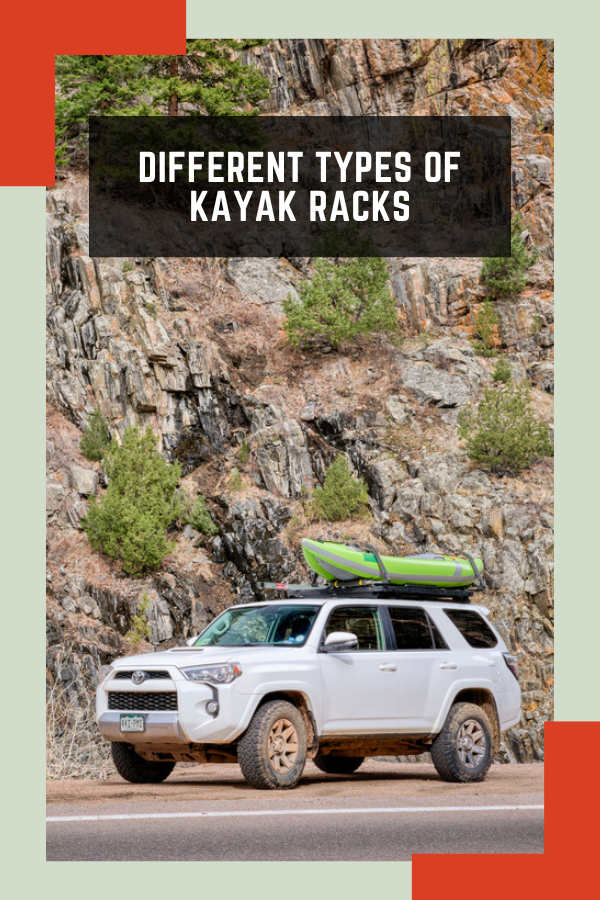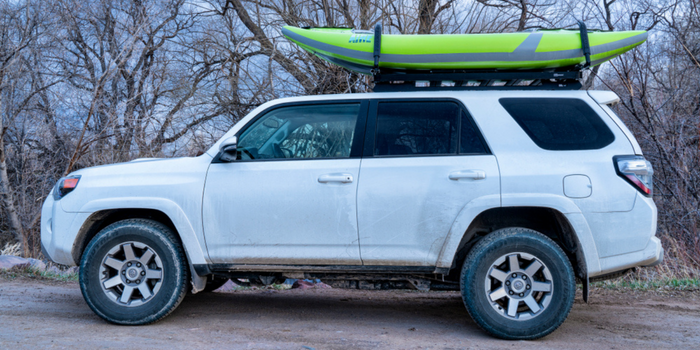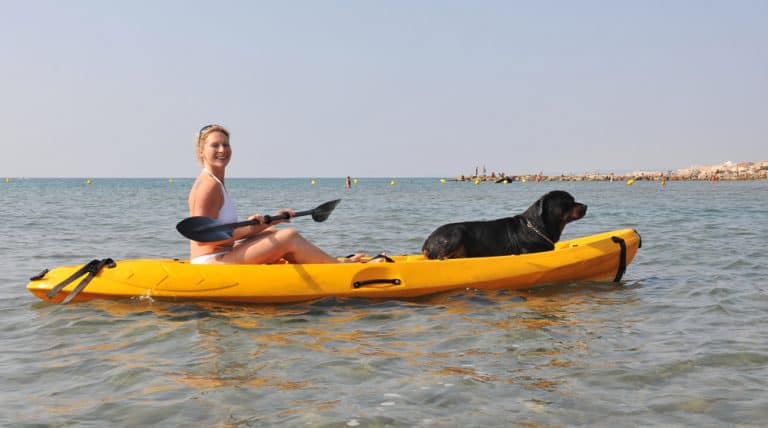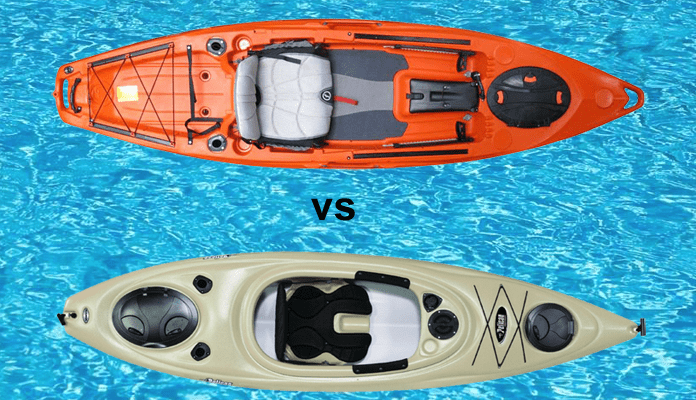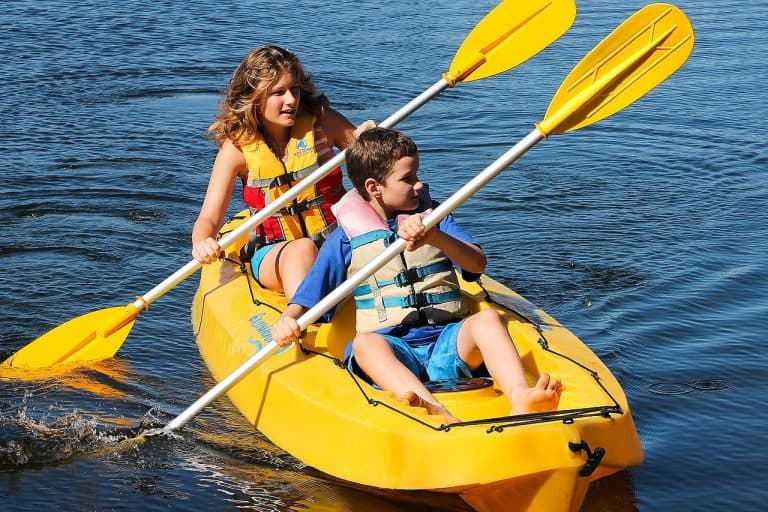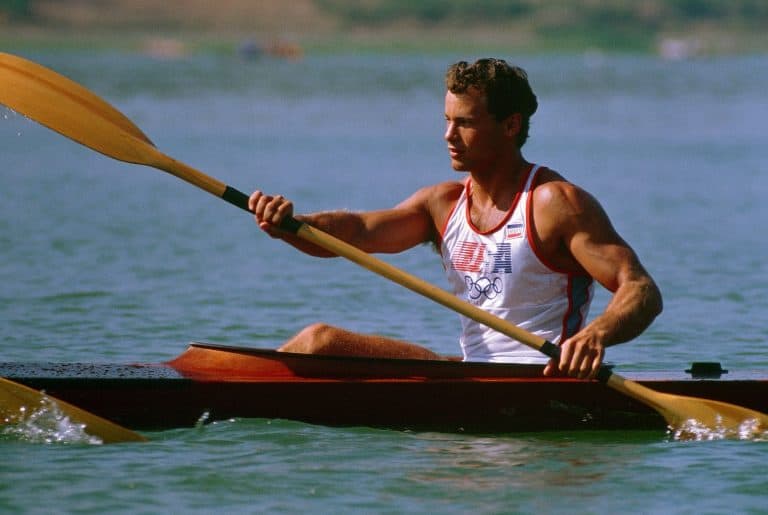Several ways to transport a kayak exist, but roof racks are perhaps the safest and most popular method. These racks, which you install on the top of your car, truck, or RV, allow you to store your kayaks and transport them to your launch spot or camping site.
However, did you know that there are actually a few types of kayak racks? While all of them serve a similar purpose, there are certain pros and cons associated with each one.
Today, I will show you five different kayak roof racks and explain their advantages and disadvantages. At the end of this article, you will not only know which kind of roof rack to choose for your purposes, but you will also have a better understanding of how to use roof racks safely.
Different Types Of Kayak Racks
1. J-Cradles
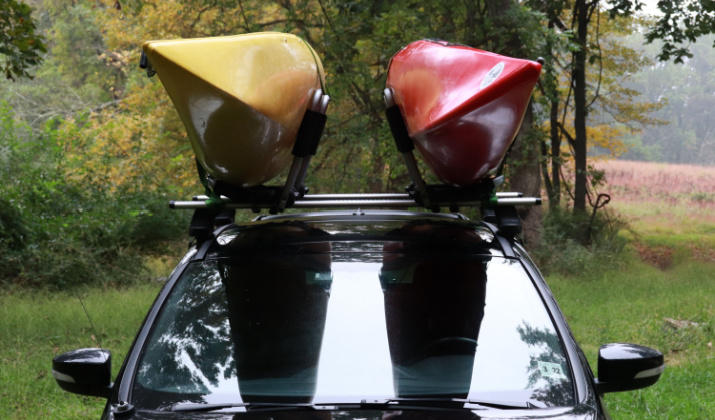
Image Source: Shutterstock
The first type of kayak rack we’ll be looking at is the J-cradle. As its name suggests, the rack is curved, in the shape of a J, allowing you to fit your kayak snugly inside.
Other names for the J-cradle include:
- J-bars
- Cradle racks
- J-hooks
J-cradles typically come in a pair, as you’ll need two pieces to hold your kayak in place. However, you can also get a four-piece set, allowing you to transport two kayaks on your roof.
One of the advantages of the J-cradle is that if you already have crossbars on your vehicle roof, installing them is pretty straightforward. It should only take 10-20 minutes.
Many J-racks come with clamps that allow you to quickly clamp them to different types of crossbars, including square and circle crossbars. Furthermore, some come with locks that enable you to lock them to the crossbars, so nobody steals them.
Not only that, but they don’t cost that much money, making them a cost-effective option, especially for owners of small vehicles.
On the other hand, if you don’t have crossbars, you will need to buy and install them first before you can install J-racks. You must have horizontal crossbars running from the passenger to the driver’s side, not just vertical crossbars.
Once you lift the kayak and place it in the J-racks, with the back of the kayak facing the longer side of the cradle, you’ll need to tie it into place to secure it while traveling.
I recommend using cam straps. You’ll loop them through the long part of the J-cradle first, over the kayak, and then secure them on the shorter end of the J-cradle.
Some people find it easier to loop the straps through the long part of the J-cradle before lifting the kayak onto the racks.
Lifting the kayak on the racks on your vehicle’s roof is actually one of the challenging parts of using a J-cradle, and it’s why J-racks are best if you have a small car that is not too tall.
Another disadvantage of J-racks is that they can’t always fit every kayak model, particularly larger kayaks. A canoe, in particular, is not a great fit for J-racks.
Check out our full guide on how to load a kayak onto a J-rack.
2. Saddles (Horizontal Racks)

Image Source: Shutterstock
Saddle kayak racks are a bit different from J-cradles. Instead of one side being long and the other short, the shape resembles a horse saddle, with the two ends being the same length.
Due to their shape and position, they allow your kayak to rest flat on its hull during transport.
That’s why they are also commonly called horizontal kayak racks.
What are some of the advantages of the saddle rack? The first is stability.
Due to the position of the kayak and the fact that the rack covers much of the hull, the kayak is more stable, with less of a chance of it falling off and being unfastened. Furthermore, because the racks are big, they are perfect for bigger kayaks and even canoes.
Horizontal kayak racks do have some disadvantages. The first is the price – they tend to be more expensive than J-racks.
Furthermore, since you’ll be laying your kayak flat on its hull, it will take up more space on your roof. If you want to store more than two kayaks, you’d be better off opting for a J-rack or vertical stacking rack.
Depending on the size of your roof, you may be able to fit two kayaks there, but there won’t be a lot of space left over.
Many horizontal kayak racks, particularly the pricier ones, come with lift assistance. They extend down the side of your vehicle, so you don’t have to lift your kayak all the way up to the roof of your car.
Also Read: Best Kayak Carts, Wheels, & Trolleys
3. Stackers (Vertical Racks)
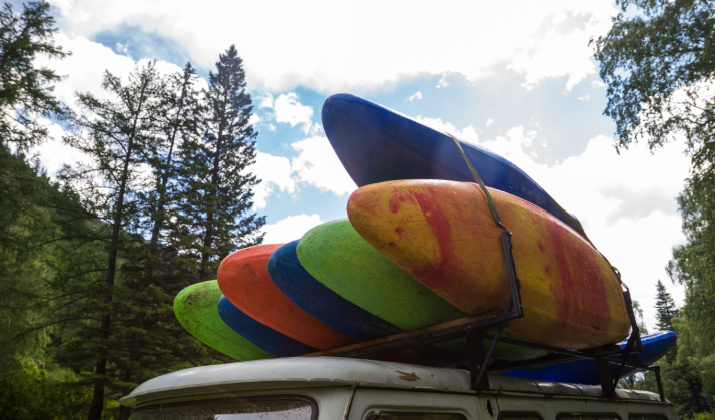
Image Source: Shutterstock
The opposite of horizontal racks are stackers, also known as vertical racks. They are called such because they allow you to stack multiple kayaks, side by side, on your rooftop.
Instead of the kayaks resting on their hulls, they rest on their sides. These racks allow you to optimize your free roof space to transport more than two kayaks, making them perfect for family and group trips.
You can usually hold at least four kayaks in a vertical stacker rack. However, while stackers allow you to store more kayaks, they are less stable.
Fortunately, most of them come with durable straps that you can use to secure the kayaks in place. Nevertheless, you have to think about how the added weight of an extra two kayaks will affect your driving and fuel economy (more on that later).
Vertical kayak stacker racks can also be helpful if you don’t have many kayaks but want to keep your roof space for other cargo, such as camping gear.
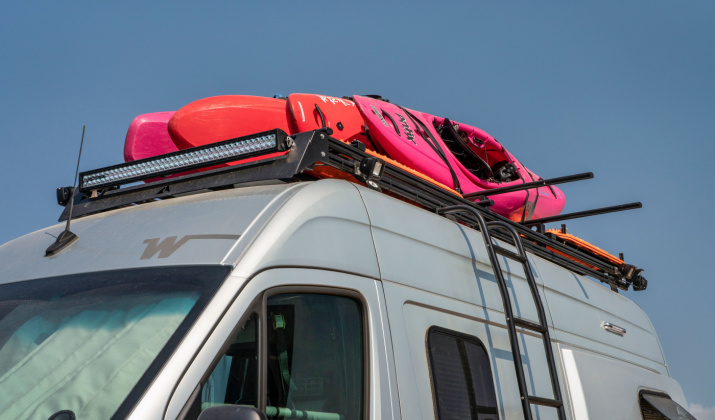
Image Source: Shutterstock
4. Inflatable Roof Racks/Soft Temporary Racks
Just like there are inflatable kayaks, there are inflatable roof racks. You’d be surprised by how strong and durable these inflatable crossbars can be.
For example, this particular inflatable roof rack has a load capacity of 175 pounds and fits most cars. You secure the frames in place by looping them and connecting them through the car doors and under the roof, and you can remove and deflate them when not in use.
Not all soft and temporary roof racks are inflatable. They can also be made of foam or other soft materials that are inexpensive to produce.
This one, for example, can be secured under the hood of your car if there are no lashing points.
Inflatables and soft pads are usually affordable, sometimes running as low as $50. Not only that, but they are very versatile – you can quickly install and uninstall them, so you don’t have to drive to work with a kayak rack installed on your roof the Monday after your weekend kayaking trip.
Soft kayak racks, especially inflatable ones, are also very easy to transport and store. If you plan on renting a car and transporting a kayak on it, they can come in handy – just make sure the rental agreement actually allows you to use them and transport a kayak on your roof.
On the flip side, there are some significant disadvantages to using a soft or inflatable kayak rack, which is why they aren’t that popular.
First, because they are soft, they allow the kayak to bounce around a bit more. Therefore, there is a risk that the kayak can ding, dent, scratch, or otherwise damage the roof of your car.
Ultimately, though, that depends on the quality of the soft rack, how securely it holds the kayak in place, and the weight of your kayak. In general, soft kayak pads can’t tolerate loads as heavy as hard racks can.
Another disadvantage is that rain can get into your car. That’s because you need to secure the soft rack by looping it through your car doors, which creates space between the car door and your vehicle, allowing rain to get in if it’s pouring.
5. Truck Utility Racks
If you own a pickup truck, you can use a standard truck utility rack to hold your kayak in place. They are also called bed toppers because they go over the bed of your pickup truck, just like crossbars would over the top of a car.
It’s certainly better than just putting your kayak in the bed of the pickup truck. It won’t be secured well there unless you have some strong straps.
Here are the top 10 kayak racks for trucks.
6. Hitch Mounts
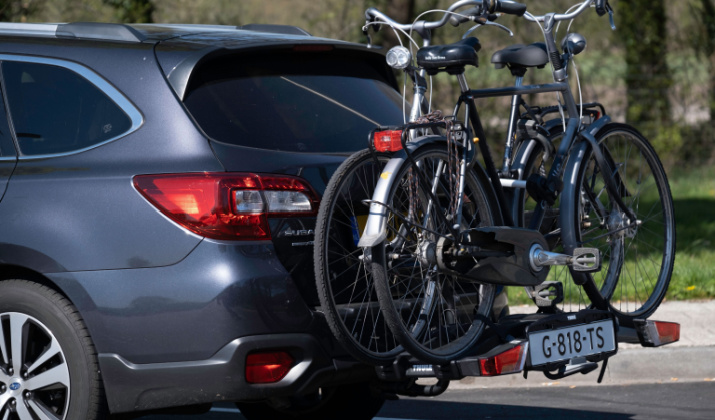
Image Source: Shutterstock
For larger vehicles, such as RVs and 4x4s, a hitch mount can be a good option as well. They’re like bike mounts for the back of your car, but for kayaks.
Typically, these hitch mounts allow you to stack two kayaks vertically on the back of your truck or Jeep. One of the advantages of this type of rack is that it’s much easier to load the kayaks there than lifting them all the way onto the roof of your vehicle, especially if you have an RV with a high roof.
Tips for Using a Roof Rack to Transport a Kayak
Whether you bought your kayak rack online or made a DIY kayak rack yourself, here are some tips for using it safely.
Make Sure the Kayak Is Secured
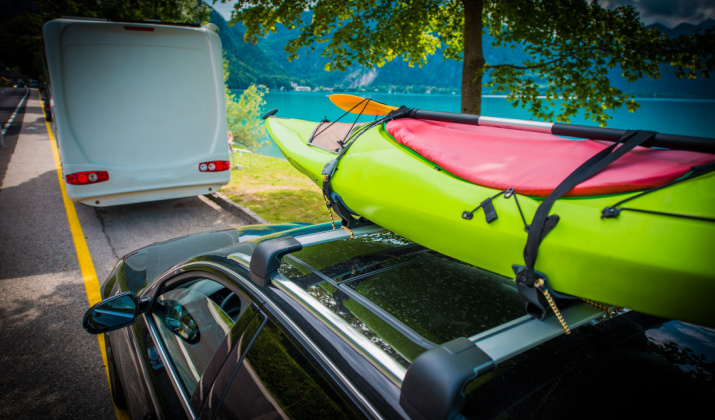
Image Source: Shutterstock
You need to double-check that the straps are tight and hold the kayak securely in place. Otherwise, the kayak can fall down or simply bounce around and damage your car.
I suggest driving for 10-15 minutes and then getting out to check your kayak. Is it still in the same place you left it, or has it shifted?
In addition, it’s worth periodically tightening the crossbar system and rack into place.
Check out our guide to strapping a kayak to your roof rack.
Check the Roof Rack’s Weight Limit
Each roof rack has a weight limit, and you should never exceed it. The instruction manual will typically contain information about the weight limit.
When buying racks online, check the weight limit before you buy to make sure the rack can hold your kayak.
Know the Laws

Image Source: Shutterstock
Your state may regulate the transport of kayaks on vehicle rooftops. For example, there may be a maximum overhang limit – the maximum amount a kayak can stick out in the front or back of your vehicle.
Furthermore, you may also need a marker or red flag to warn drivers that you are carrying something.
For example, in Florida, the law requires you to use a red flag when you have cargo that protrudes four feet or more behind your vehicle.
How Many Kayaks Can You Fit on Your Roof?
That depends on the type of rack you have. Most racks allow you to fit two, perhaps three kayaks, on your roof.
For example, a horizontal rack will only allow you to fit two kayaks. However, vertical stackers usually allow you to fit up to four kayaks on your roof.
Should You Get a Kayak Rack With Lift-Assist Technology?
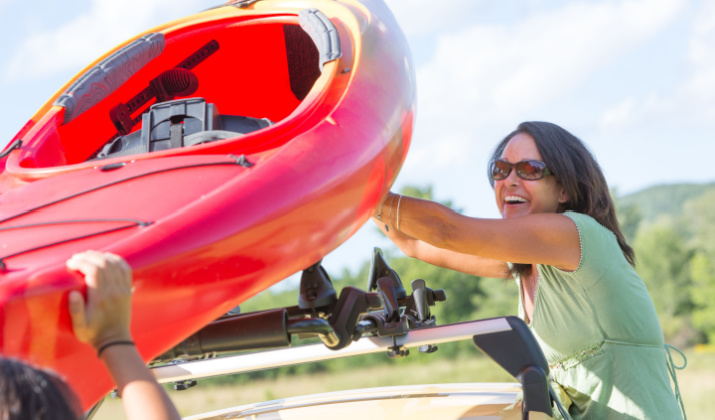
Image Source: Shutterstock
Lifting a kayak can be difficult. Kayak racks with lift-assist technology make it a lot easier.
Some have extendable bars that extend to the side of your vehicle, while others even extend down to reduce how high you need to lift the kayak. Others come with rollers that allow you to roll the kayak onto your vehicle’s roof without needing to lift it.
Kayak racks that come with lift-assist technology tend to cost quite a bit more.
However, they may be worth it if you have physical limitations that prevent you from lifting the kayak high up, have a very heavy kayak, or are always going kayaking alone and don’t have anybody to assist you with raising the kayak.
If you’re having difficulty loading your kayak onto your rack, check out these easy-load kayak racks.
Do You Need a Crossbar System?
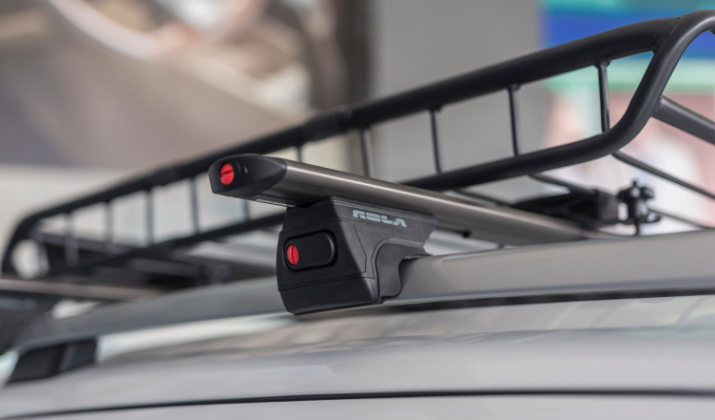
Image Source: Shutterstock
Yes, you will need a crossbar system for most roof racks. They allow you to stabilize heavy loads and ensure the kayak is secured in place.
However, you don’t need a crossbar system if you buy temporary pads or inflatable racks. Also, if you buy a hitch mount, you don’t need a crossbar system.
How Does Having a Kayak Affect Your Driving?
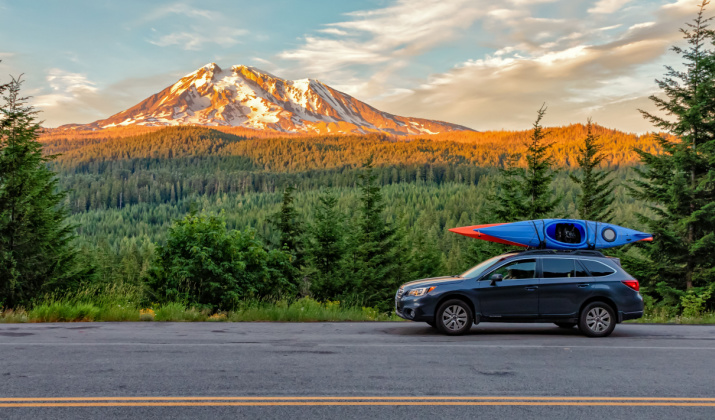
Image Source: Shutterstock
Many people wonder how having kayaks strapped onto the roof of their vehicle will affect their driving. The good news is that as long as you strap the kayaks on securely, there shouldn’t be much of a noticeable difference.
Safety
I recommend driving a bit slower when you have a kayak strapped to your roof, especially at first. Give yourself some time to get a feel for how a kayak on your roof changes the aerodynamics of your car and your driving before you get onto the interstate.
You probably won’t notice much of a difference, but you may find it a bit harder to make sharp turns while maintaining stability. Ultimately, it depends on how big your car is, the type of rack you’re using, and how heavy the kayak is.
The kayak rack manufacturer may recommend a maximum speed limit, but you’re usually able to go up to 80-90 miles per hour without any issues.
A more significant concern is not strapping your kayak down securely. The last thing you want is for your kayak to slide off while you’re speeding down the highway.
If it slides down the front of your vehicle, it could obscure your vision and create an obstacle in your path, leading to a severe accident. If it slides off the side or back of your vehicle, it could cause a hazard for other drivers.
Fuel Economy

Image Source: Shutterstock
Not everyone knows this, but strapping a kayak to your roof can affect your gas mileage. According to one study, kayaks altered gas mileage and reduced fuel economy by 28 percent.
Even just having roof racks on your car, without any kayak on it, decreases fuel economy by around seven percent. That’s another reason you might want to use soft or inflatable kayak racks, as you can take them off when not in use (they are also not as heavy as hard racks).
The study involved wind tunnel testing, which manufacturers use to improve the aerodynamics and performance of vehicles by detecting which exterior design elements negatively influence them.
The larger your kayak is, the more likely it is to impact your gas mileage. Over the long run, keeping a kayak strapped to your vehicle will cause you to use up the gas a lot quicker and spend more money on fuel.
Alternative Ways to Transport a Kayak
If you don’t want to use a roof rack for whatever reason, there are other ways to transport a kayak without a roof rack. Let’s take a look at the most common ones.
Get an Inflatable Kayak
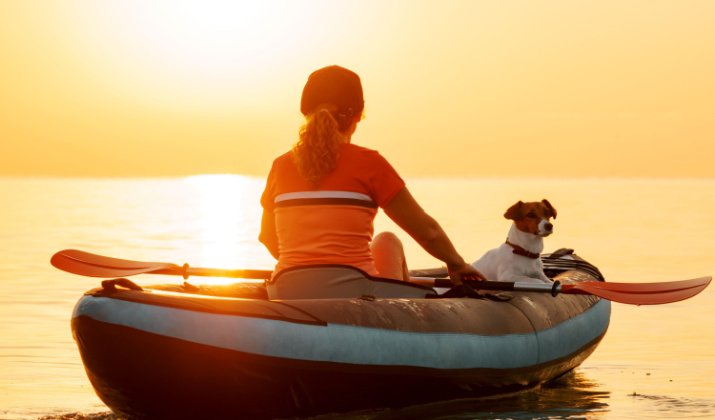
Image Source: Shutterstock
Inflatable kayaks are perfect if you have limited space or don’t want to waste gas money unnecessarily. They are also great if you don’t have a vehicle at all.
When you’re not using your inflatable kayak, you can deflate it and put it in a bag. Many inflatable kayaks come with carrier bags that fit the kayak perfectly and allow for easy transport.
Most inflatable kayaks these days are made of durable PVC materials. They are resistant, long-lasting, and not easy to puncture.
Furthermore, they typically come with multiple air chambers so that even if one air chamber is punctured, your kayak will still remain afloat.
They are generally affordable as well. You can put them in your trunk or other small spaces, freeing up your roof for your camping gear or other cargo.
There are some downsides to using an inflatable kayak, though.
You will have to spend 5-15 minutes inflating and deflating the kayak each time you want to use it, and you will also have to carry around a pump. If you forget your pump, you won’t be able to inflate your kayak.
Get a Folding Kayak
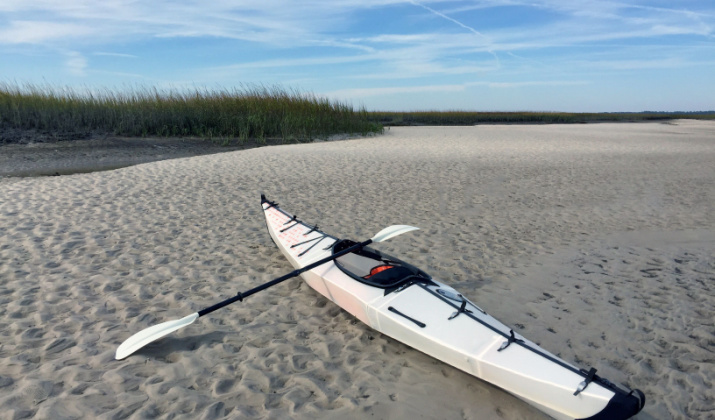
Image Source: Shutterstock
An alternative to the inflatable kayak is the folding kayak, which has two or more sections, allowing you to fold the kayak when not in use. You can store it in your trunk or even carry it if it comes with shoulder straps.
You can transport a folding kayak on the roof of your car, even if you don’t have a rack. Simply tie it and secure it in place by looping and tying the straps through the car doors and under the ceiling, similar to inflatable roof racks.
Folding kayaks can be surprisingly expensive, but they’re usually made of high-quality material that will last you for a long time. Typically, folding kayaks can last for 20,000 fold cycles or more before you need to buy a new one.
Use a Kayak Trailer
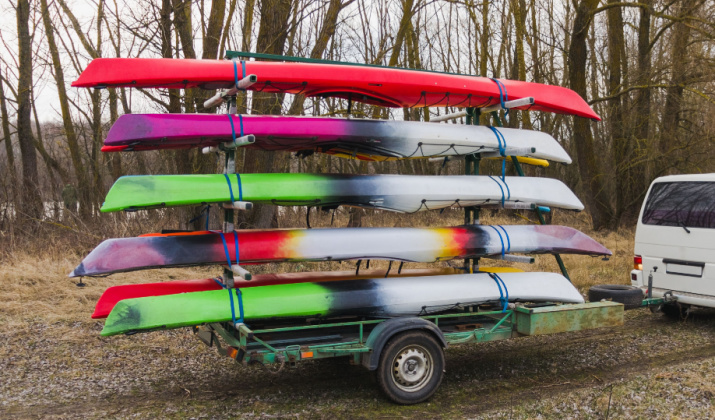
Image Source: Shutterstock
If you don’t like the idea of not having a traditional, hard kayak, you can use a kayak trailer instead of a roof rack. Both have pros and cons.
Kayak trailers can typically hold a lot more than a kayak. They’re multipurpose – you can put your camping gear or a bicycle there.
In addition, you can simply detach your trailer whenever you don’t want to use it.
Finally, loading a kayak onto a trailer is a lot easier than lifting it up and getting it on the roof of your car.
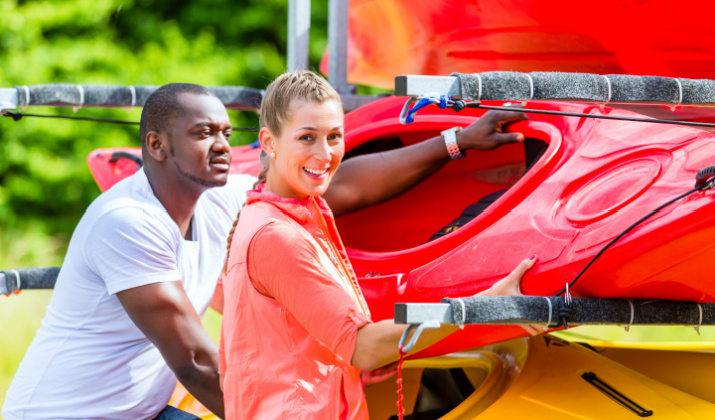
Image Source: Shutterstock
In fact, you don’t have to unload your kayak at the end of your trip at all. When you get home, simply detach the trailer, and reattach it the next time you go on a trip.
However, trailers can be expensive. Furthermore, you will need to fit your car with a hook system so that you can attach the trailer.
Not only that, but it will take some time to get used to driving with an attached trailer. You will need to relearn everything, especially turning corners – you can’t turn that sharply.
Reversing isn’t easy when you have a trailer. You also want to avoid sudden braking and stopping.
Finally, you will need somewhere to store your trailer, whether it’s a driveway or extra garage space.
Wrapping It Up
Transporting a kayak isn’t tricky. If you have an average car and kayak, I recommend getting J-cradles, as they are affordable and easy to install.
I don’t typically recommend soft kayak racks or trailers. Soft kayak racks should be used only in a pinch – they shouldn’t be your first option.
Trailers can be expensive, and you also need to maintain them to make sure they are road-worthy.
If you liked this article, please share it with a friend! Also, check out these great kayak racks for cars, trucks, and SUVs.
